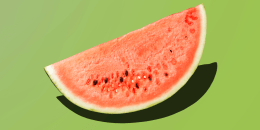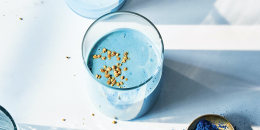Fruit can be a surprising source of calcium, a mineral that’s usually associated with milk and other dairy products.
Calcium is famous for its role in keeping bones and teeth strong, but it has many more functions in the body. It helps to release hormones, muscles to move, nerves to carry messages, and blood to flow and clot, according to the National Institutes of Health.
Yet, 42% of Americans don’t get enough, studies have found. Calcium is considered a dietary component of “public health concern” for the U.S. population because people aren’t eating enough nutrient-dense foods, according to the current Dietary Guidelines for Americans.
Including a variety of fruits as part of a balanced diet can help support calcium intake, especially when combined with other nutrient-rich foods, says Patricia Bannan, a registered dietitian in Los Angeles and author of “From Burnout to Balance.”
“Fruits aren’t top sources of calcium compared to dairy, fortified plant milks or leafy greens,” Bannan tells TODAY.com. “But they can still add up throughout the day.”
Adults need 1,000 milligrams of calcium a day, according to the NIH. Children, teens and older adults — especially women — need more.
For context, a glass of milk provides about 300 milligrams of calcium, while most fruits offer 20 to 50 milligrams per serving, so they contribute smaller amounts individually, Bannan says.
“Calcium-fortified 100% fruit juice can be a great option for those who don’t consume dairy,” she notes.
An 8-ounce glass of fortified juice contains a similar amount of the calcium found in a glass of milk. But whole fruits provide additional benefits like fiber, satiety and a broader spectrum of nutrients, so fortified juice should complement — not replace — other calcium-rich, whole food sources, Bannan advises.
If you’re a vegan, fruits alone usually won’t provide enough calcium, but they do contribute — especially when combined with other calcium-rich plant foods like fortified plant milks, tofu, almonds, tahini and leafy greens, she adds.
“A thoughtfully planned plant-based diet can absolutely meet calcium needs, and fruits can make a sweet and helpful addition,” Bannan says.
Here are nine fruits with the most calcium:
Prickly pears
- 1 cup of raw prickly pears, 83 milligrams of calcium
Widely found in the Southwest, this cactus fruit — particularly its skin — is “remarkable” for its calcium content,” studies have found. The fruit can be juiced or used in drinks, desserts and jellies, according to New Mexico State University.
Prickly pears can also be eaten raw, with their flavor compared to that of strawberries, watermelons and citrus, depending on the variety, the University of California notes.
Oranges
- 1 large orange, 65 milligrams of calcium
- 1 cup of orange juice with added calcium, 349 milligrams of calcium
Registered dietitian Natalie Rizzo, nutrition editor for TODAY, calls oranges “an immune-boosting powerhouse.” Sweet, tangy and juicy, they’re among fruits highest in vitamin C and are also a good source of potassium.
Many brands of orange juice are fortified with calcium for an extra boost, but Rizzo recommends sticking to one glass per day.
Black currants
- 1 cup of raw black currants, 61 milligrams of calcium
Black currants are part of the berry family and have an aromatic sweet-tart flavor.
Their deep color signals powerful bioactive compounds that can benefit health, with researchers noting their “anti‐inflammatory, antioxidant, and antimicrobial properties,” which have led black currants to be called “super fruits.”
They can be eaten raw or dried, juiced or turned into jams.
Dried figs
- ¼ cup of dried figs, about three to five pieces, 60 milligrams of calcium
Sweet and satisfying, figs are among fruits highest in natural sugar for healthy energy.
Bannan calls them “one of the best fruit sources” of calcium. They’re also rich in fiber, antioxidants and minerals.
Figs are a nourishing snack on their own or make a great topping for plain yogurt for an extra boost of calcium.
Blackberries
- 1 cup of fresh blackberries, 42 milligrams of calcium
High in fiber and low in calories, blackberries contain powerful antioxidants. The nutrient content of berries in general offers a “notable arsenal that reduces risk of cancer,” studies have found.
You can eat blackberries fresh on their own, or add them to oatmeal, yogurt, a smoothie or a fruit salad.
Papaya
- 1 cup of papaya, 29 milligrams of calcium
The tropical fruit is packed with nutrients including magnesium, potassium, folate, lycopene, and vitamins A, C, E and K.
Besides calcium, papaya also comes with some iron.
It’s listed as one of the “longevity superfoods” eaten in the Blue Zones — places around the world where people live extraordinarily long and healthy lives.
Kiwi
- 1 kiwi, 26 milligrams of calcium
The little green fruit offers big health benefits. Kiwi has more vitamin C than an orange, is among fruits highest in magnesium and potassium, and contains little sugar.
It comes with plenty of fiber for gut health and has been shown to help with chronic constipation.
Prunes
- ¼ cup of prunes, 19 grams of calcium
- 1 cup of prune juice, 30 milligrams of calcium
Famous for their ability to get the digestive system moving, prunes also deliver some calcium for bone health.
Dense and chewy, they’re a nutritious snack. Prune juice comes with similarly powerful health benefits.
Dried apricots
- ¼ cup dried apricots, 18 milligrams of calcium
Raw apricots naturally contain a bit of calcium. Since dried fruit has the water removed, it becomes more concentrated in nutrients. So dried apricots contain a good amount of calcium, plus iron.
They’re also among fruits highest in protein.











